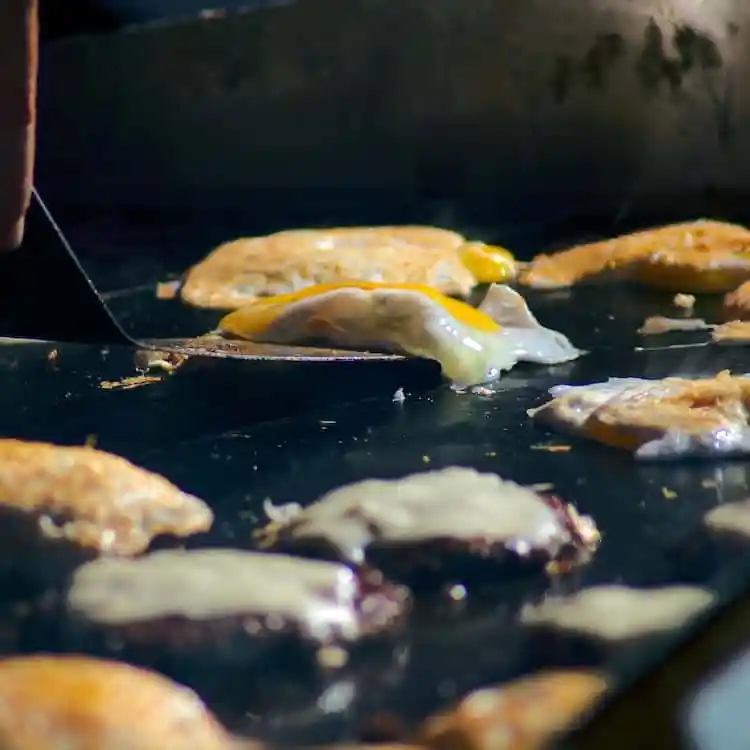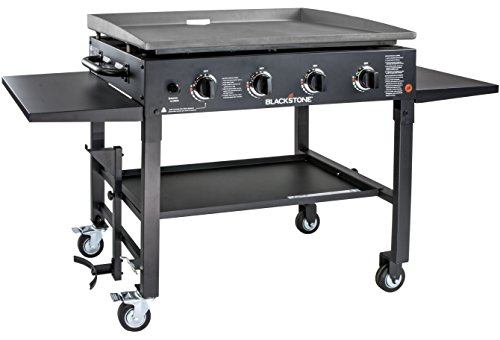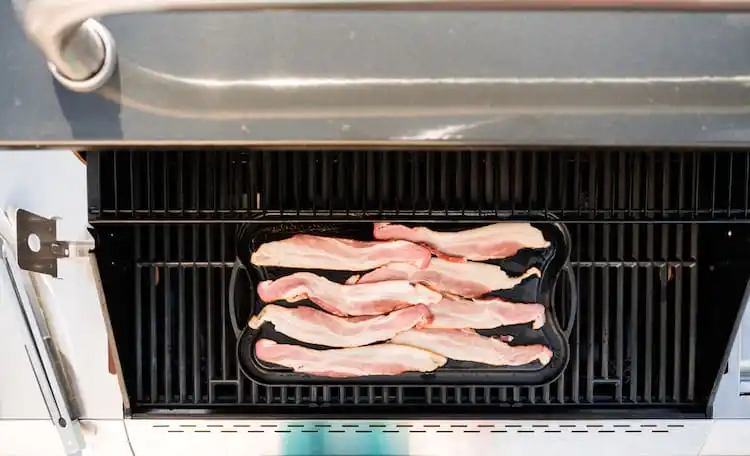Grills and griddles are different cooking surfaces that suit different types of food, and picking the correct one is vital to getting the delicious outcome you’re looking for.
Let’s take a look at the differences, and explore the kinds of foods that work best with each.
What is a griddle?
If you’ve ever been to an old-fashioned diner, then that colossal hissing hot plate in the kitchen is an excellent example of a griddle.
To put it simply, a griddle is a flat metal cooking surface that is heated from underneath. Essentially, it’s a big square frying pan.
The flat cooking surface suits foods that are granular, like rice, or liquid heavy, like pancakes or eggs. However, much like a frying pan, you can cook almost anything on it.

Types of griddle

Since they are a relatively simple piece of cooking equipment, griddles come a number of shapes and sizes, and you can find a model to suit almost any cooking setup.
Freestanding griddles
Freestanding griddles like the excellent Blackstone Gas Griddle or Pit Boss 4 Burner Gas Griddle come attached to their own stand and cart, and are a great choice if you want an ample, flat cooking space in your back yard.
Most freestanding griddles are gas-powered, with multiple burners mounted underneath the steel cooking surface.
Depending on the model you choose, you can also expect casters for more effortless movement, easy-clean grease traps, and folding side tables to help you with your cooking preparation.
Tabletop griddles
Similar to a hot plate, tabletop griddles are a small, portable cooking surface that can be taken with you when camping or going to a cookout.
They can also be used in the kitchen to cook up a great breakfast, and stored away without taking up much cupboard space.
The Blackstone Tabletop Gas Griddle is an excellent example of what makes tabletop girdles so popular. At 17.5 x 18 x 8.5 inches, it’s compact enough that traveling with it, or storing it, isn’t a hassle.
Despite its small size, the Blackstone Table Top 17’s burners, powered by a 1 lb propane bottle, put out 12,000 BTUs of cooking heat, which is more than enough to get it cooking quickly and effectively.
Insert Griddles
Usually an addition to a BBQ or grill, an insert griddle is a flat square cooking surface that can be fitted over a heating element or firepit to turn it into a griddle.
If you’ve already got a prized gas BBQ or charcoal grill and don’t have the space to invest in a freestanding griddle, then an insert griddle is a great compromise that only increases the utility of your existing setup.
What type of food do you cook on a griddle?
Because griddles provide consistent heat across a large, flat cooking surface, they are best used for cooking foods that you just wouldn’t be able to cook on a traditional BBQ or grill.
- Eggs, pancakes, rice dishes, and fajitas are great examples of delicious foods that can only be prepared on a cooking surface with no holes in it.
- The traditional use for a griddle, harking back to our diner example, is to make a fried breakfast featuring favorites such as fried eggs, sausages, hashbrowns, bacon, beans, and tomatoes.
- The high heat of the griddle makes it perfect for Mexican food and can mimic a wok so you can stir-fry Chinese, Japanese, and Korean cuisines.
- Traditional BBQ foods like burgers, steak, hot dogs, and chicken will all cook perfectly well on a griddle.
With the ability to prepare everything from burgers to bulgogi, having access to griddle really opens up the range of food you can cook.https://youtube.com/embed/dRrmyGYweto?feature=oembed
What is a grill?
In contrast to a griddle’s single fat surface, a grill’s cooking surface is a series of slatted cooking grates, generally suspended above a charcoal firepit or gas burners.
The benefit of a grill is that it allows the grease and water from the food to run off between the slats of the grate, it exposes the food to an open flame, and the metal grills transfer heat, browning the meat on contact and intensifying the Maillard reaction.
The greater exposure of the food to the cooking flame on a grill is important as wood and charcoal grills are often prized for the smokey flavor they impart to the food.
What are the main differences between a griddle and a grill?
Other than the shape of the cooking surface, one of the primary differences between a grill and a griddle is the temperature they work best at.
- Grills are at their best when they are heated up to around 400°F (204°C). This allows the heat to transmit through the metal grates and cause those intensely browned strips that are the hallmark of outdoor grilling. This hot and fast approach works well with foods like steak, where you can get a good fast sear on the outside without overcooking that perfect pink center.
- Griddles work best at around 350°F (177°C), which is still more than hot enough to sear meat and fry bacon, but not so hot that you can’t cook foods in a sauce or cook vegetables without burning the skin while the rest remains raw.
Which is better for you?

The simple answer is, both!
Because the grill and the griddle cook at different temperatures and work best when cooking different types of food, having them both to hand gives you the broadest range of options.
The good news is if you don’t have room for both a freestanding griddle and a traditional grill, an insert griddle means you can still have the best of both worlds.
Now you can cook steak the evening before and breakfast the morning after, all on the same rig. Perfection!
Wrapping it all up
So now you know the difference between a grill and a griddle and can choose the one that’s right for you. Or, even better, get both and get your cook on!
If you’ve got any fantastic griddle recipes you want to share with us or advice on how to get the best from your griddle, please let us know in the comments below.